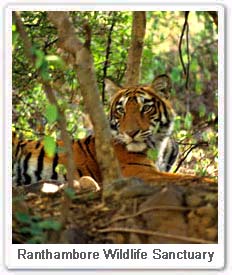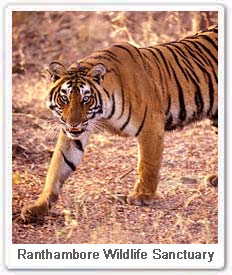Major Attractions : Tigers, Leopards, Boars.
Area Covered : 392 sq-km.
Ideal Time to Visit the Park : During the months of October - March and April to June.
Nearest Attractions : Ranthambore Fort (the 10th century fort) & Jogi Mahal in the park complex. Bakaula, Kachida Valley, Lakarda and Anantpura are also some place you can visit.
Some Major Accesses : Sawai Madhopur (11 km), Alwar, Jaipur (145 km).
Things to Know
 Where
is the Ranthambore National Park
Where
is the Ranthambore National ParkThe Ranthambhore National Park in Rajasthan is situated in the eastern part of Rajasthan, where the Aravali Hill ranges and the Vindhyan plateau meet. The park falls under the district of Sawai Madhopur, which is also the nearest town located 11 km from the park.
The Ranthambore National Park was once the hunting ground of the Maharajas of Jaipur. The rivers Chambal in the South and Banas in the North bound the Ranthambore National Park in Rajasthan India. Six man made lakes are the central focus of the Ranthambore park and many longlasting streams meanders through the entire park. The Ranthambore National Park has internal drainage and has no connection with any river system, even though two rivers bound the Park in it's north and south side.
The Climate in the Ranthambore Wildlife Sanctuary
The park experiences drastic variations in climatic conditions. The temperature range is extreme with the mercury dipping to around 2 degrees centigrade in the winters and rising all the way up to 47 degrees centigrade in the summers.
Important Dates in the Ranthambore's History
The Ranthambore Tiger Reserve was declared a wildlife sanctuary in year 1957 and in year 1974 it gained the protection of "Project Tiger". It received it's status of a National Park in year 1981.
The Ecological System in the Ranthambore Wildlife Sanctuary
For the wildlife lovers, Ranthambore Wildlife Sanctuary Rajasthan offers an enthusiastic diversity of flora and fauna. The landscape fo the Ranthambore National Park is formed of massive rock formations, steep scarps, perennial lakes and streams and forest suddenly opening up into large areas of Savannah. The terrain of Ranthambore Wildlife Sanctuary fluctuates between impregnable forests and open bush land. Ranthambore National Park in Rajasthan is famous for its Tigers and is a delight treat for the photographers. For a relatively small area, the park has a rich diversity of fauna and flora - species list includes 300 trees, 50 aquatic plants, 272 birds, 12 reptiles including the Marsh Crocodile & amphibians and 30 mammals.
The Flora in Ranthambore National Park
The Ranthambore National Park Rajasthan is dotted with ancient Banyan Trees, Dhok & Pipal trees, clusters of mango trees and crisscrossed with evergreen patches. The forest is the typically dry deciduous type, with Dhok, being the most obvious tree found through out the region.

Apart from Dhok, other species found here are - Am (Magnifera Indica), Imli (Tamarindicus indica), Babul (Accasia nilotica), Banyan (Ficus benghalensis), Ber (Zizyphus mauritania), Dhak or Chila (flame of the forest), Jamun (Syzygium cumini), Kadam (Authocephalus cadamba), Khajur (Phoenix sylvestris), Khair (Accacia catechu), Karel (Capparis decidua), Khejda (Prosopis specigera), Kakera (Flacourtia indica), Mohua (Madhuca indica), Neem (Azadirachta indica), etc.
The Fauna in the Ranthambore Wildlife Sanctuary
Tigers, the park's pride makes it one of the best places in the country to observe them. Apart from that a large numbers of Leopards, Striped Hyenas, Sambar deer, Chital, Nilgai, Common or Hanuman langurs, Macaques, Jackals, Jungle cats, Caracals, Sloth bears, Black Buck, Rufoustailed Hare, Indian Wild Boar, Chinkara, Common Palm Civets or Toddy cat, Coomon Yellow Bats, Desert Cats, Fivestriped Palm Squirels, Indian False Vampires, Indian Flying Foxes, Indian Foxes, Indian Gerbilles, Indian Mole Rats, Indian Porcupines, Longeared Hedgehogs, Ratels, Small Indian Mongoose, Small Indian Civets and Common mongoose are seen in the park.
The Avifauna in the Ranthambore Wildlife Sanctuary
Ranthambore national park is also one of the richest reserves in bird species. Ranthambore, due to its varied terrain and abundance of water bodies, has an excellent population of birds, resident and migrant. There are about 272 different species of birds found in the Ranthambore National Park Rajasthan. The birds in the Park includes a large number of migratory birds. Some of the many varieties of birds seen here are the great Indian horned owl, various species of eagles such as Bonelli's eagle and the crested serpent, spoonbills, partridge, quail, parakeets, Common kingfishers, owls and storks, geese and ducks. The most visible bird in Ranthambhore is the peacock, India's national bird.
The Reptiles in the Ranthambore Wildlife Sanctuary
 Snub
Nosed Marsh Crocodiles, Desert Monitor Lizards, Tortoise, Banded Kraits,
Cobras, Common Kraits, Ganga Soft Shelled Turtles, Indian Pythons, North
Indian Flap Shelled Turtles, Rat Snakes, Russel's Vipers, Saw-scaled Vipers
and the Indian Chamaeleon.
Snub
Nosed Marsh Crocodiles, Desert Monitor Lizards, Tortoise, Banded Kraits,
Cobras, Common Kraits, Ganga Soft Shelled Turtles, Indian Pythons, North
Indian Flap Shelled Turtles, Rat Snakes, Russel's Vipers, Saw-scaled Vipers
and the Indian Chamaeleon.The Fishes in the Ranthambore National Park
Ranthambore due its numerous water bodies has a relatively large variety of fish to boast of. These species consist of : Bita (Labio Rohita), Catla (Catla catla), Greyei (Chhana matulion), Lanchi (Walago auto), Mahseer (Tor tor), Mirgal (Cirrchinus mrigala), Rohu (Labio rohita), Savank (Chhana punctatus), Seenghari (Mystus seenghala).
Safaris at Ranthambore Wildlife Sanctuary
Delhi - Ranthambore - Bharatpur – Agra - Bandavgarh – Kanha - Nagpur – Mumbai
Ranthambore Wildlife Sanctuary Travel Circuit
Delhi - Ranthambore - Bharatpur – Agra - Bandavgarh – Kanha - Nagpur – Mumbai
How to Reach the Ranthambore National Park
Air : Jaipur at 145 km is the nearest airport from Ranthambore wildlife sanctuary.
Rail : Ranthambore National Park is around 11 km away from Sawai Madhopur railway station, that lies on the Delhi to Bombay trunk route.
Road : A good network of buses connect Sawai Madhopur, the nearest town from Ranthambore to all the major cities within the state of Rajasthan.






